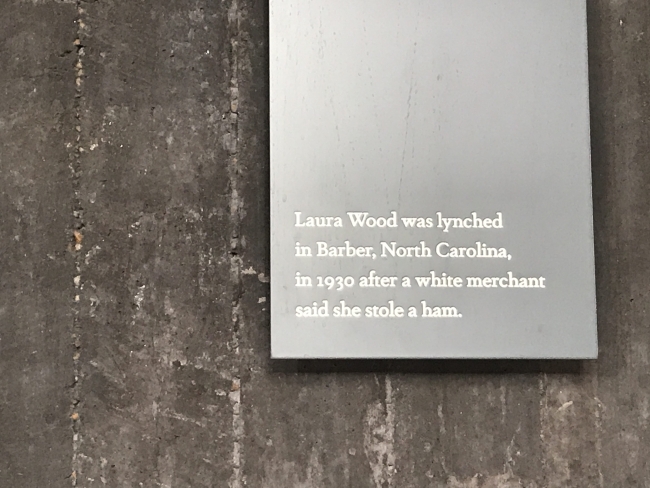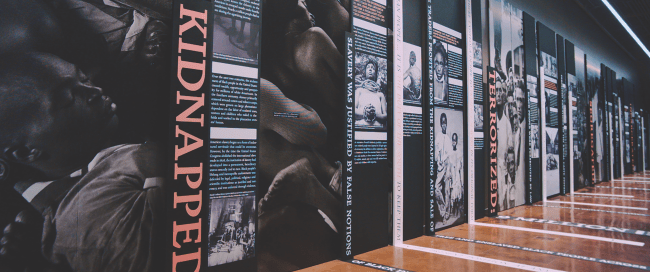Moments of Truth: Alumni Dedicated to Creating a More Just, Fair Society
July 24, 2019
- Author
- Lisa Patterson
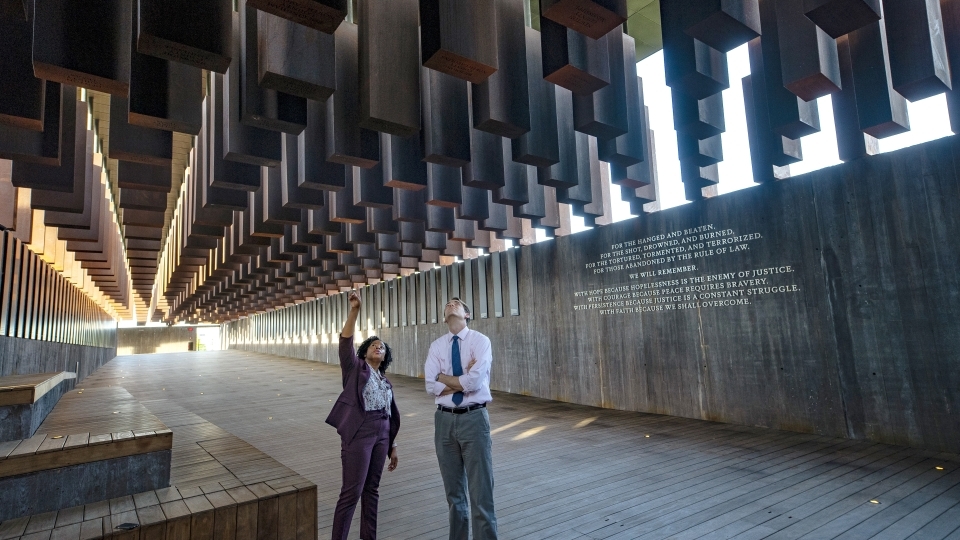
Steel coffin-like columns bear the names of more than 4,400 victims of racial terror lynchings at the National Memorial for Peace and Justice in Montgomery, Alabama. Through their work with the Equal Justice Initiative, the nonprofit organization responsible for the new memorial, Kiara Boone ’11 and Mickey Hubbard ’08 seek to create a more just world through education and legal action.
Glass jars of dirt line a wall, a spectrum of brown: rich chernozem, red clay or light and sandy. The soil metaphorically holds the blood of lynchings, scooped from their locations, which are etched on the glass vessels along with a date and name—Willie McDaniel, Jim Tate, Joe Richmond.
The jarred earth marks sites that span the United States, memorializing thousands of African Americans killed in post-Civil War racial terrorism. The wall should be a reflective space, but from a nearby exhibit voices of civil rights opponents bark hateful rhetoric—the inherited cacophony of a violent past.
The wall is part of a narrative within the Equal Justice Initiative’s (EJI) Legacy Museum that links the injustices of slavery to present-day consequences. The 11,000-square-foot museum occupies the site of a former Montgomery, Alabama, warehouse where enslaved people were held for auction.
The jars of dirt share the museum space with prison-style phone booths where visitors can “talk” to a formerly incarcerated person. A young man wearing a black t-shirt emblazoned with the EJI logo hovers near the booths, chatting with museum visitors.
Not far from the flesh-and-blood man is a woman sitting in one of the booths, looking back at a recording of the same man—in the video image, he’s sitting against a backdrop of cement blocks, holding a phone to his ear, and wearing a prison jumpsuit.
The man is Kuntrell Jackson. On this day, Jackson will share his story with Davidson College students, faculty and staff, around 70 of whom had boarded charter buses bound for Montgomery the day before.
At 14, Jackson was tried as an adult and received a mandatory life sentence without parole on a capital murder conviction. That was in 1999.
Jackson was with two older boys when they began discussing the idea of robbing a video store. When they arrived at the store, the other two boys went in, but Kuntrell stayed outside by the door. One of the other boys shot the clerk, and then all three fled without taking any money.
In an historic ruling in Jackson v Hobbs and Miller v Alabama, the U.S. Supreme Court ruled that mandatory life-without-parole sentences for all children 17 or younger convicted of homicide are unconstitutional. EJI fought to get Jackson a new sentencing hearing. His life sentence was overturned, and he was granted parole and released from an Arkansas prison in February 2017. He's now part of the EJI re-entry program.
“For Kuntrell, being able to engage with people in the museum is a part of his own journey,” says Kiara Boone ’11. “He’s able to see how people are responding to the museum space, and to his particular narrative—and he’s having those conversations in person.”
Conversations. Dialogue. Two of Montgomery’s most talked about new spaces—the Legacy Museum: From Enslavement to Mass Incarceration and the National Memorial for Peace and Justice—are meant to get people talking: to each other, to community leaders, to politicians, to people whose lives bear little resemblance to their own.
The museum guides visitors through the history of enslavement in the United States, from the domestic slave trade and slave market holding pens to modern-day prison cells. The memorial, where 800 steel coffin-like columns bear the names of more than 4,400 victims of racial terror lynchings, is a powerful reminder of American atrocities not found in history textbooks.
Throughout the visit, Boone, EJI deputy director of community education, and Mickey Hubbard ’08, a staff attorney with the organization, facilitate discussions and provide insight into the making of the museum and memorial.
The trip is a special addendum to the “Memory Studies” course, which brings together five courses taught by faculty in different disciplines around the phenomena of collective memory.
The students have been primed for the experience with readings and videos. They arrive at the hotel stiff and tired from the seven hour bus ride, then strike out on their own for dinner and a walk around downtown Montgomery. Later, they file into the hotel conference room, across the busy, well-worn carpet to padded metal chairs. Boone greets them for an orientation about what they will experience the next day.
‘Post-Brown’ World
Kiara Boone knows how to command a room. In a denim jacket and gray EJI t-shirt, hair pulled back into a ponytail, she could be a student—but today she is the professor. It wasn’t an obvious path.
“No traffic lights, just stop signs,” is how Boone describes Macon, Mississippi. The one grocery store in town (after the Piggly Wiggly closed) and high school football (longtime state 4A champs) brought people together in Boone’s largely racially segregated hometown.
“One of the things that always stood out to me is, as we were learning about the civil rights movement and specifically about Brown v. Board of Education and the integration of schools, I thought it was interesting to be in a post-Brown world and in a school system that was almost 100 percent African American,” she says. “I say ‘almost’ because we had one non-black student who was in my year, and he was also a student of color.”
Despite administrators and educators who cared, the community’s schools were often under threat of state probation—but Boone got out.
For her last two years of high school the academic stand-out was accepted to attend the Mississippi School for Mathematics and Science, one of the most diverse and resource rich schools in Mississippi. The school focused on preventing the state’s brain drain problem by providing a free, academically rigorous STEM education.
“Going to MSMS opened doors for me that would have been more difficult to access at my old school,” Boone says. “College had a similar impact on my life.”
An English teacher whose daughter attended Davidson turned her on to the school. Northwestern emerged as the other final choice, but Davidson’s personal attention, campus beauty and Davidson Trust-funded scholarship won.
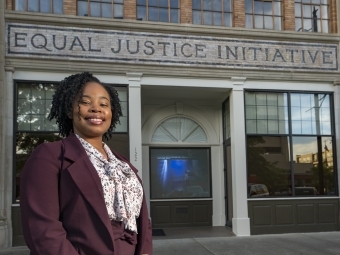
Kiara Boone ’11
Davidson bore little resemblance to Macon, but racial divisions cross state lines.
Boone volunteered with organizations doing outreach in the town, and she dove into student life as a Chidsey Leadership Fellow, residence advisor, member of the Alpha Kappa Alpha Sorority and Shades of Brown Step Team, and as vice president of the Black Student Coalition.
As a political science major, she started to see ways to act on a question that had formed in her young mind in Mississippi: How do you create avenues to move money from wherever it exists to places that need it most?
Her interest in the nonprofit sector and philanthropy led to a post-graduate fellowship with the Jessie Ball duPont Fund in Florida, an “eye-opening” experience.
“That work exposed me to the real consequences of the Florida prison pipeline,” she says. “I was learning more and more about how kids are treated in the criminal justice system.”
While doing research to help expunge childrens’ criminal records, she learned about EJI and another fellowship opportunity. What was supposed to be a two-year stint with EJI morphed into a permanent position, and she’s now going on six years with the organization.
“I had gotten over my ‘I have to get out of Mississippi’ mentality and was trying to figure out how to help this region of the country that I care so deeply about, that I call home, reflect the values of so many of its people,” she says, “and create an opportunity for the rest of the country to see themselves in the South’s reflection.”
Addressing Injustice
Montgomery, Alabama, is a city of contradictions—the birthplace of the modern civil rights movement and the most active slave trading port in the South; home to Martin Luther King Jr.’s first parish, the Dexter Avenue King Memorial Baptist Church, and temporary home to Jefferson Davis, the sole inhabitant of the First White House of the Confederacy.
It's the capital of a state that has voted twice in this century to keep language in the state constitution that mandates racial segregation of education.
In April 2019, nearly one year after the Legacy Museum and National Memorial opened, the U.S. Justice Department released a 56-page report detailing the shocking conditions within Alabama’s overcrowded, understaffed prison facilities. The state has one of the nation’s highest incarceration rates.
“We have a system of justice in this country that treats you much better if you are rich and guilty, than if you are poor and innocent,” says Bryan Stevenson in a TED Talk that has been viewed nearly six million times. Stevenson is founder and executive director of EJI. In the talk, titled “We Need to Talk About an Injustice,” Stevenson lays bare some hard facts:
In 1972, there were 300,000 people in jails and prisons. Today, there are 2.3 million. The United States now has the highest incarceration rate in the world. We have seven million people on probation and parole. One out of three black men between the ages of 18 and 30 is in jail, in prison, on probation or parole. Over 40 percent of children of color live below the federal poverty level. And in the South, you’re 11 times more likely to get the death penalty if the victim is white than if the victim is black, and 22 times more likely to get it if the defendant is black and the victim is white.
But numbers don’t move people. People move people. Stevenson found that out as a first year law student. While interning with a small Georgia law firm, Stevenson had to tell a condemned man that he was not at risk of execution for the next 12 months. The man’s gratitude and the conversation they shared galvanized Stevenson into action and set him on his current path.
He founded EJI in 1989 with a commitment to “change the narrative about race in America.”
“Our system prioritizes conviction and incarceration over compassion, justice and fairness,” says Mickey Hubbard ’08, a Bonner Scholar and political science major who now works on the EJI legal team.
Stevenson and the EJI mission inspire him—he has found a vocation.
Hubbard’s demeanor invites conversation. Like Boone, he is quick with a smile or a laugh. Also like Boone, Hubbard grew up in the South and acutely felt the context of his surroundings.
“Gainesville [Georgia] is a place like many others that still have open wounds from Jim Crow, from segregation,” he says. “You see it in how the neighborhoods are drawn, how the schools function.”
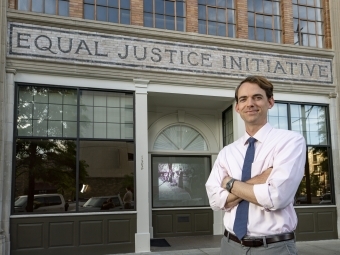
Mickey Hubbard ’08
Hubbard took note of a strange phenomenon—with each passing year more and more of the students of color he had attended kindergarten with were left out of college preparatory track. By high school, his classes were nearly all white.
Hubbard says he came to Davidson to channel his interests, turn interest and knowledge into action, and learn about those around him. He volunteered in Davidson, Charlotte and Statesville, working with organizations that offered legal assistance for children, diverted people with addiction issues out of the justice system and into treatment, and provided services to the homeless.
“For me, one of the big lessons I learned was that there are different ways to address injustice,” Hubbard says, “like direct services, organizing, advocacy and legislative work—and we need them all.”
He came to this understanding through the exploration and reflection that is built into the Bonner Scholar experience. The scholars meet regularly to talk about, reflect on and compare the wide-ranging work they do in the community.
“It allows a significant opportunity to think critically about what you’re doing,” he says. “The same is true for the classes I was taking—whether it was an international development course or a class on political philosophy.”
After Davidson, Hubbard attended law school at Columbia University with a goal of returning to the South. The job at EJI came next, and it felt like coming full circle.
“EJI is unique in what it does,” Hubbard says. “We do direct legal services, legislative advocacy, community education… we do a number of things to address racial injustice, and for me that really makes EJI a very effective place to work.”
Hubbard’s work takes him from the state prisons of Alabama to the U.S. Supreme Court. There are victories and defeats.
One recent win for EJI stands out. Hubbard was a member of the legal team that argued in front of the Supreme Court on behalf of EJI client Vernon Madison. The court ruled in favor of Madison, a 68-year-old man on death row who suffers from severe vascular dementia following multiple life-threatening strokes.
The 5-3 decision extended Eighth Amendment protections to individuals with dementia. Madison is legally blind, incontinent, cannot walk without a walker, speaks with slurred speech, and has no memory of the crime or the circumstances that brought him to death row.
Facing History
The students walk from the hotel down mostly deserted streets, past a life-sized statue of one of the city’s most celebrated sons, Hank Williams Sr. They gather under a cloudy, gray sky outside the entrance of the Legacy Museum.
Three large images of children in orange prison jumpsuits, their backs to the camera, line the white brick wall near the entrance. Scrawled in black paint along an adjacent wall is a Maya Angelou quotation: “History, despite its wrenching pain, cannot be unlived, but if faced with courage, need not be lived again.”
Near the museum entrance, Prof. Alan Michael Parker points out to students how the building itself provokes emotion, imposing its arguments through architecture.
Slowly, they file in, pass through security. No photography or video allowed.
The museum and memorial, nearly 10 years in the making, are the physical manifestation of EJI’s research. The spaces bridge a troubled past to a troubled present.
EJI drew inspiration from places and structures around the world that do the difficult work of reminding and educating, specifically the Memorial to the Murdered Jews of Europe in Berlin and the Apartheid Museum in Johannesburg.
The idea, Boone says, is to provide people with the space and tools they need to understand the connections between our past and contemporary issues.
“We asked, how do we continue to build out this experience, how do we continue to make this information accessible, and how do we continue making this argument that slavery didn't end in 1865, it simply evolved and we're engaging with different iterations of its oppression and its discrimination today,” she says. “That got us thinking about how we could create multiple entry points, not just one single form of engagement for everybody, but written material, visual material, immersive experiences.”
Inside the museum, the students linger in front of holograms of men, women and children in slave holding pens, and listen to their pleas to be reunited with loved ones. They stop in front of mason jars filled with soil and read the names of the victims. They watch documentaries of formerly incarcerated people describing the brutality of prison life. They consider the lives of civil rights leaders whose faces line the walls.
The professors sit with them: “Are you okay?”
Path Forward
The students make their way back to the hotel. They gather in the conference room, drag their chairs into a large, lop-sided circle, and face one another for a conversation led by Boone and Hubbard.
“We’re here,” she says, “if anyone has anything they want to share.”
A student in Prof. Kristi Multhaup’s class, who is terrified of speaking in public, asks:
“How do we bring this back [to campus]?”
This trip is taking place just four months after a group that exposes social media hate speech revealed that two Davidson students’ Twitter feeds included racist and anti-Semitic hate speech and threats. The students have since left the college.
For more than 60 uncomfortable minutes before the group goes to the National Memorial, the students talk to each other. Frustration, miscommunication, empathy.
For Boone, the tension is familiar. But she takes the long view.
“We're beginning to build on something, but the idea that there are parts of our history we don’t fully understand, I think, is the whole reason we opened these spaces,” Boone says. “We're forced to engage and have these difficult conversations and uncomfortable feelings so that we can get to this healing and repair that so many of us say that we want.”
She pauses:
“But we can't do that without truth telling.”
